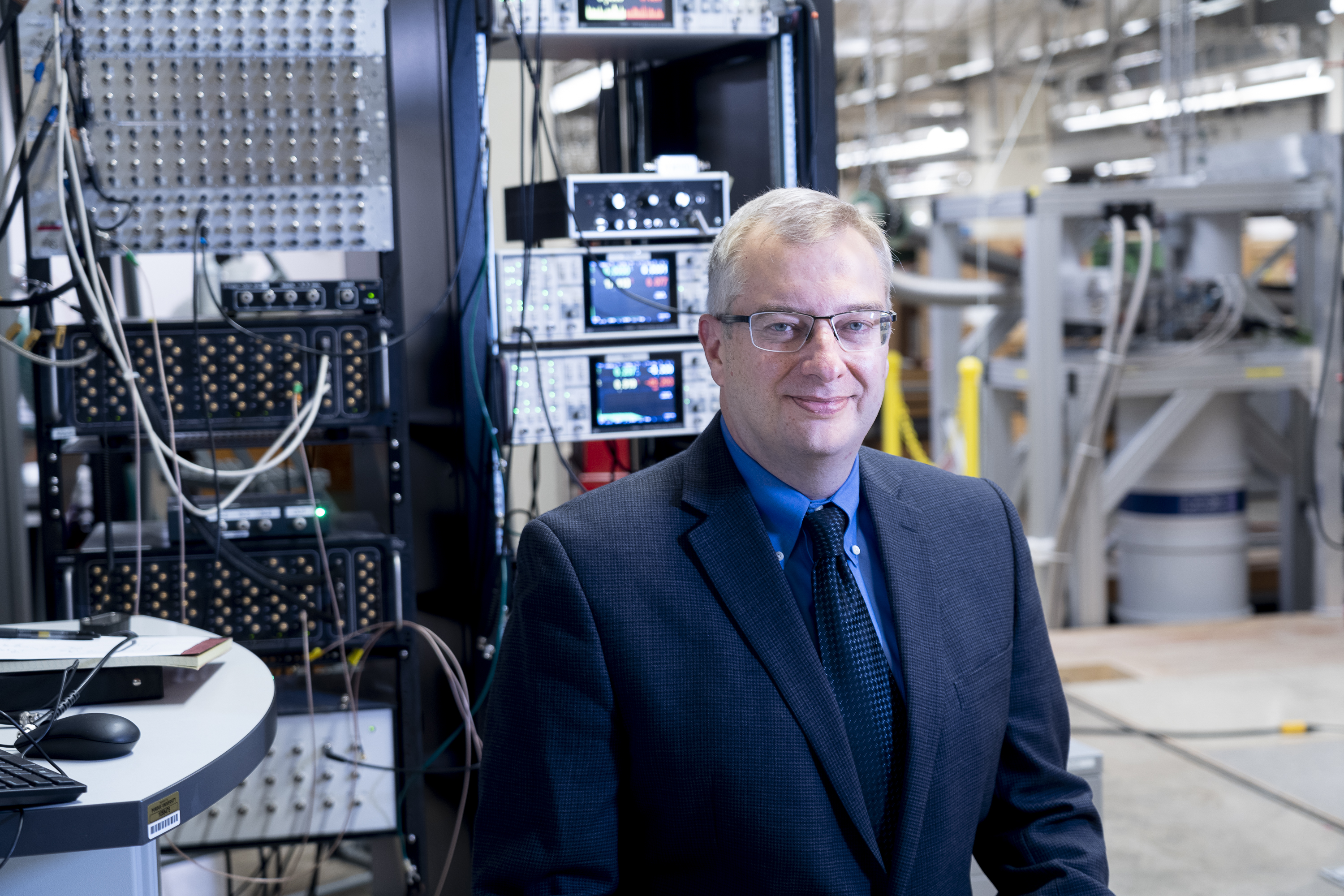Michael Manfra receives 2026 APS Oliver E. Buckley Condensed Matter Physics Prize
2025-11-05

Prof. Michael Manfra has been awarded the American Physical Society’s 2026 Oliver E. Buckley Condensed Matter Physics Prize. Purdue University photo.
Michael Manfra, the Bill and Dee O’Brien Distinguished Professor of Physics and Astronomy has been awarded the American Physical Society’s 2026 Oliver E. Buckley Condensed Matter Physics Prize which recognizes outstanding theoretical or experimental contributions to condensed matter physics.
In addition to his appointment in Physics and Astronomy, Manfra holds several titles at Purdue including professor in the Elmore Family School of Electrical and Computer Engineering, professor of materials engineering, and director of Purdue Quantum Science and Engineering Institute. Manfra also is the scientific director of Microsoft Quantum Lab West Lafayette.
His research focuses on the science of topological phases of matter and development of novel qubit platforms in which topology may provide protection against decoherence. His interests span from the fractional quantum Hall effect in the two-dimensional electron gas in AlGaAs/GaAs heterostructures to hybrid superconductor-semiconductor systems hosting topological superconductor phases. In 2020, his group reported interferometric measurement of anyon braiding, giving experimental evidence for a theoretical prediction made 40 years earlier. It is for this work that Manfra is recognized with the Buckley Prize.
According to Gabor Csathy, professor and head of the Department of Physics and Astronomy, condensed matter physics has been an important subfield at Purdue since the early days of the department when there was an intense effort in developing semiconductors for radars during World War II. Later, efforts in the department yielded numerous graduates with significant success in the semiconductor and high-tech industries. Over the last decade or so, the leadership of the Purdue University College of Science recognized work in this area and invested significant resources both in condensed matter physics and in the closely related field of quantum sciences. A notable success in condensed matter physics was achieved by physics professor Albert Overhauser, who in 1975 was honored with the Buckley Prize for inventing dynamic nuclear polarization and for theoretical studies of instabilities of the metallic state.
“I am elated that, after 50 years, we have a new Buckley Prize awarded to a colleague, this time recognized for experimental work,” Csathy said. “Distinguished Professor Michael Manfra was cited for experimental demonstration of anyonic braiding statistics of quasiparticles in the fractional quantum Hall effect. The concept of anyons is perhaps the most consequential for electronic systems confined to two physical dimensions: They are emergent particles that are neither fermions nor bosons. These particles were theorized for decades. Their direct experimental observation is a tour de force effort that involved a multipronged effort in novel sample design, state-of-the-art semiconductor growth and mastering of ultrasensitive measurements. I am especially proud that the most critical part of the experiments was performed in the Physics Building.”
In a letter presented to Manfra, John Doyle, president of the American Physical Society, said that the Oliver E. Buckley Condensed Matter Physics Prize selected Manfra and the other co-recipients based on “groundbreaking experiments that uncovered the role of vortices in the superfluid phase transition in helium films and observed anyonic braiding statistics of quasiparticles in the fractional quantum Hall effect, thus establishing the significance of topological excitations in two dimensions.”
“I am honored by this prestigious recognition of my team’s work,” Manfra said. “The experiments reported in 2020 were the culmination of 10 years of work at Purdue. Many students and postdoctoral fellows contributed to this effort that spanned from developments in materials science, to nanoscale device fabrication, to highly sensitive electronic measurements at extremely low temperature. All facets needed to be in place and optimized. I am extremely proud of my team’s accomplishments. Purdue University provided the perfect working environment to make this happen. The infrastructure, laboratory facilities and personal support I have received over the past 15 years have been a key element in our successful completion of these experiments.”
The Buckley Prize was endowed in 1952 by AT&T Bell Laboratories (now Nokia Bell Labs) and is currently co-sponsored with the HTC-VIA Group as a means of recognizing outstanding scientific work. It is named in memory of Oliver E. Buckley, an influential president of Bell Labs, and is presented annually.
About the Department of Physics and Astronomy at Purdue University
Purdue’s Department of Physics and Astronomy has a rich and long history dating back to 1904. Our faculty and students are exploring nature at all length scales, from the subatomic to the macroscopic and everything in between. With an excellent and diverse community of faculty, postdocs and students who are pushing new scientific frontiers, we offer a dynamic learning environment, an inclusive research community and an engaging network of scholars. Physics and Astronomy is one of the seven departments within the Purdue University College of Science. World-class research is performed in astrophysics, atomic and molecular optics, accelerator mass spectrometry, biophysics, condensed matter physics, quantum information science, and particle and nuclear physics. Our state-of-the-art facilities are in the Physics Building, but our researchers also engage in interdisciplinary work at Discovery Park District at Purdue, particularly the Birck Nanotechnology Center and the Bindley Bioscience Center. We also participate in global research including the Large Hadron Collider at CERN, many national laboratories (such as Argonne National Laboratory, Brookhaven National Laboratory, Fermilab, Oak Ridge National Laboratory, the SLAC National Accelerator Laboratory, etc.), the James Webb Space Telescope, and several observatories around the world.
Written by: Cheryl Pierce, Purdue University College of Science
Contributors: Michael Manfra, Bill and Dee O’Brien Distinguished Professor of Physics and Astronomy, professor of electrical and computer engineering, professor of materials engineering, director of Purdue Quantum Science and Engineering Institute
Gabor Csathy, professor and head of the Department of Physics and Astronomy
Photo by: Purdue University